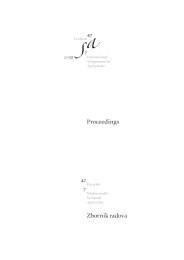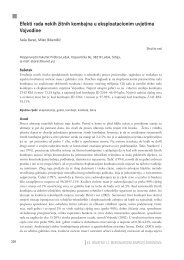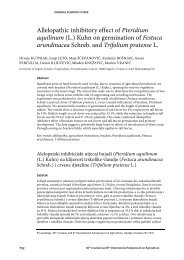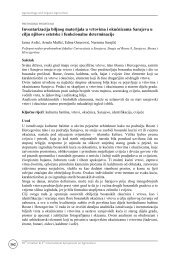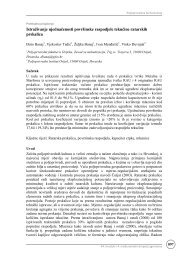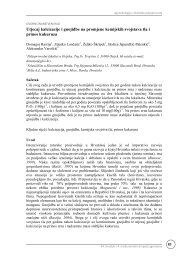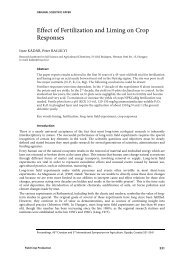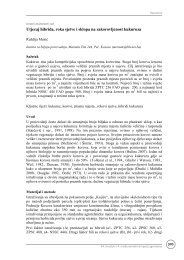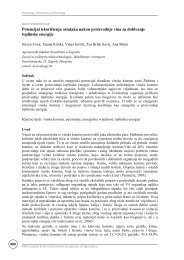46th Croatian & 6th International Symposium on Agriculture - hr
46th Croatian & 6th International Symposium on Agriculture - hr
46th Croatian & 6th International Symposium on Agriculture - hr
You also want an ePaper? Increase the reach of your titles
YUMPU automatically turns print PDFs into web optimized ePapers that Google loves.
Toxic influence ORIGINAL of nickel (Ni) SCIENTIFIC <strong>on</strong> germinati<strong>on</strong> PAPER<br />
of two cultivars of wheat (Triticum aestivum L.)<br />
Toxic influence of nickel (Ni) <strong>on</strong> germinati<strong>on</strong> of<br />
two cultivars of wheat (Triticum aestivum L.)<br />
Snežana BRANKOVIĆ 1 , Milan STANKOVIĆ 1 , Vera ĐEKIĆ 2 , Marina TOPUZOVIĆ 1<br />
1 University of Kragujevac, Faculty of Science, Radoja Domanovića 12, 34000 Kragujevac, Serbia,<br />
(e-mail: pavsnez@yahoo.co.uk)<br />
2 <strong>Agriculture</strong> Research Institute Serbia, Small Grains Research Center, Save Kovačevića b.b., 34000 Kragujevac, Serbia<br />
Abstract<br />
The paper presents results of researches of the effect of several doses of NiCl2 (0.00195, 0.00391,<br />
0.0078, 0.0156, 0.0313, 0.0625, 0.125, 0.25, 0.5 and 1M) <strong>on</strong>% of germinati<strong>on</strong>, the length of root<br />
and shoot of two wheat Triticum aestivum L. cultivars - Kruna and Toplica. The results<br />
indicated that% of germinati<strong>on</strong>, root and shoot length of investigated cultivars were remarkable<br />
reduced with the rise of NiCl2 c<strong>on</strong>centrati<strong>on</strong> after 3. and 5. days of incubati<strong>on</strong>. The average<br />
values of germinated seeds illustrated higher% of germinati<strong>on</strong> of cultivar Kruna than Toplica in<br />
both measurements by about 20%. The analysis of the average length of root and shoot showed<br />
remarkable differences in their length between cultivars and also between measurements after 3.<br />
and 5. incubati<strong>on</strong> days of each cultivar. Results obtained by analysis of variance present high<br />
statistic differences (p≤0.01) am<strong>on</strong>g c<strong>on</strong>centrati<strong>on</strong>s of% of germinati<strong>on</strong> after 3. and 5. days, as<br />
both root and shoot length after 3. days of incubati<strong>on</strong>. Our results also illustrate statistical<br />
significant differences (p≤0.05) of% germinati<strong>on</strong> between cultivars after 3. days and of the shoot<br />
length after 5. days of incubati<strong>on</strong>.<br />
Key words: wheat cultivars, germinati<strong>on</strong>, nickel<br />
Introducti<strong>on</strong><br />
Some toxic metals at low doses are essential micr<strong>on</strong>utrients for higher plants, am<strong>on</strong>g them is nickel (Ni). In<br />
higher doses heavy metals may causes metabolic disorder and growth inhibiti<strong>on</strong> for most of the plant species<br />
(Fernandes and Henriques, 1991; Claire et al., 1991). High levels of Ni in plants growth media are phytotoxic.<br />
Slight increases in the growth of a number of plants species were attributed to low levels of Ni, but its<br />
functi<strong>on</strong> is not known. Possible benefitic effects of Ni <strong>on</strong> plant growth are poorly defined and not<br />
understood. Some studies have c<strong>on</strong>firmed that the nickel is essential for activati<strong>on</strong> of urease, an enzyme<br />
involved with nitrogen metabolisam that is required to process urea. Possibly urease and, therefore, Ni might<br />
be required for the mobilizati<strong>on</strong> of stored seed-nitrogen t<strong>hr</strong>ough ureides or arginin during early stage of<br />
seedlig growth. Without Ni, toxic levels of urea accumulate, leadind to the formati<strong>on</strong> of necrotic lesi<strong>on</strong>s<br />
(Welch, 1981; Barker and Pilbeam, 2007). The present manuscript reports results of the percentage of<br />
germinated seeds, the root and shoot length of two cultivars Kruna and Toplica of wheat (Triticum aestivum<br />
L.) which were treated with different c<strong>on</strong>centrati<strong>on</strong> of NiCl2.<br />
Materials and methods<br />
In order to reasearch effects of nickel to germinati<strong>on</strong> of wheat seeds NiCl2 (6H2O) which was obtained from<br />
Merck, Germany was used. The effect of several doses of NiCl2 (0.00195, 0.00391, 0.0078, 0.0156, 0.0313,<br />
0.0625, 0.125, 0.25, 0.5 and 1M) <strong>on</strong>% of germinati<strong>on</strong>, the length of root and shoot of two cultivars Kruna and<br />
Toplica of wheat (Triticum aestivum L.) was studed. For the nickel treatment of seed, the initial soluti<strong>on</strong> of<br />
NiCl2 in distilled water at the c<strong>on</strong>centrati<strong>on</strong> of 1M was prepared. From the initial soluti<strong>on</strong>, 10 diluti<strong>on</strong>s with<br />
descending gradients of c<strong>on</strong>centrati<strong>on</strong> were prepared up to the c<strong>on</strong>centrati<strong>on</strong> of 0.00195M NiCl2. The seeds<br />
were germinated in Petri dishes with double layer of filter paper soaked in distilled water (c<strong>on</strong>trol) and 1M -<br />
Proceedings. 46 th <str<strong>on</strong>g>Croatian</str<strong>on</strong>g> and 6 th <str<strong>on</strong>g>Internati<strong>on</strong>al</str<strong>on</strong>g> <str<strong>on</strong>g>Symposium</str<strong>on</strong>g> <strong>on</strong> <strong>Agriculture</strong>. Opatija. Croatia (413-416)<br />
Secti<strong>on</strong> 3 . Genetics, Plant Breeding and Seed Producti<strong>on</strong> 413
414<br />
Snežana BRANKOVIĆ, Milan STANKOVIĆ, Vera ĐEKIĆ, Marina TOPUZOVIĆ<br />
0.00195M NiCl2 soluti<strong>on</strong>s. Petri dishes were kept under standard laboratory coditi<strong>on</strong>s (light/darkness - 16/8h,<br />
temperature 22/18ºC and humidity 55/65%). Data are the results from t<strong>hr</strong>ee separate analysis with 100 seeds<br />
in each Petri dishes. Statistical analysis was performed based by STATISTICA. The data were analyzed by<br />
analysis of variance (ANOVA) to determine the effect of treatments. The percentage of germinated seed and<br />
the length of root and shoot were recorded for each sample t<strong>hr</strong>ee and then five days after seeding in the same<br />
experiment.<br />
Results and discussi<strong>on</strong><br />
The analysis data of the percentage of germinati<strong>on</strong> showed that the number of germinated seeds depended<br />
<strong>on</strong> the c<strong>on</strong>centrati<strong>on</strong> of NiCl2 in the medium. In comparis<strong>on</strong> with c<strong>on</strong>trol, (sample without NiCl2),% of<br />
germinati<strong>on</strong>, root and shoot length of investigated cultivars were c<strong>on</strong>siderably reduced with the rise of NiCl2<br />
c<strong>on</strong>centrati<strong>on</strong> in both measuremets (Tab. 1 and 2). The average values of germinated seeds illustrated<br />
higher% of germinati<strong>on</strong> of cultivar Kruna than Toplica in both investigated days by about 20%. Cultivar<br />
Kruna showed the biggest average value of germinated seeds after 3. days (63.4%). The germinati<strong>on</strong> wasn’t<br />
found in the samples of 1 M soluti<strong>on</strong> of NiCl2 (except at cultivar Toplica after 5. days of incubati<strong>on</strong>). The<br />
average value of percentage of germinated seeds of both cultivars didn’t remarkably change between first and<br />
sec<strong>on</strong>d measurements. Seed germinati<strong>on</strong> and seedling growth inhibiti<strong>on</strong> by heavy metals has also been<br />
reported by (Eskew et al., 1984; Prasad, 1995; Lee et al., 1999; Reeves and Baker, 2000; Liu et al., 2004; Jun et<br />
al., 2009; Stanković et al., 2010).<br />
Table 1. Percentage of germinati<strong>on</strong>, root and shoot length after t<strong>hr</strong>ee days of incubati<strong>on</strong><br />
% of germinati<strong>on</strong>1 root length1 (mm) shoot length1 C<strong>on</strong>centrati<strong>on</strong><br />
(mm)<br />
of NiCl2(M) Kruna Toplica Kruna Toplica Kruna Toplica<br />
1 0 0 0 0 0 0<br />
0.5 3.33±2.31 1.33±2.31 0 0 0.01±0 0.003±0.006<br />
0.25 10±3.46 5.33±3.01 0 0 0.01±0 0.01±0<br />
0.125 9.33±1.15 0 0.007±0.011 0 0.015±0.003 0<br />
0.0625 81.33±7.6 9.33±9.01 0.01±0.01 0.003±0.005 0.010±0.001 0.008±0.007<br />
0.0313 96±3.46 13.33±2.3 0.022±0.025 0.007±0.011 0.011±0.001 0.012±0.004<br />
0.0156 97.33±1.1 41.3±18 0.059±0.026 0.017±0.02 0.012±0.002 0.011±0.002<br />
0.0078 100±0 92.67±2.3 0.034±0.005 0.018±0.017 0.017±0.005 0.011±0.002<br />
0.00391 100±0 98±0 0.039±0.009 0.045±0.007 0.037±0.003 0.033±0.009<br />
0.00195 100±0 99.33±1.2 0.038±0.009 0.125±0.091 0.037±0.036 0.272±0.20<br />
0 100±0 96±1 0.096±0.01 0.135±0.01 0.22±0.01 0.278±0.10<br />
¯¯х 63.4±44.7 41.15±43 0.028±0.031 0.032±0.055 0.04±0.06 0.058±0.11<br />
1 Values expressed as mean ± standard error (n=3)<br />
The analysis of the average length of root and shoot showed remarkable differences in their length between<br />
cultivars and also between measurements after 3. and 5. incubati<strong>on</strong> days of each cultivar. C<strong>on</strong>sidering, root<br />
and shoot length of cultivar Toplica showed higher average values in both of investigated days than of<br />
cultivar Kruna. After the first measurement, the average values of root length of cultivar Toplica was 0.032<br />
mm, and sec<strong>on</strong>d mesurement showed remarkable difference in value and was 2.26 mm. Significant reducti<strong>on</strong><br />
in root and shoot growth of both cultivars with the increase in c<strong>on</strong>centrati<strong>on</strong> of Ni treatment were also<br />
observed as compared to c<strong>on</strong>trol. Only in the sample with 0.00195 M of NiCl2 the length of root and shoot<br />
was higher than c<strong>on</strong>trol sample which is in accordance with earlier researches (Welch, 1981). The root didn’t<br />
develop at both cultivars in the samples with 1 M till 0.25 M soluti<strong>on</strong> of NiCl2 in both studies days.<br />
On the other hand, the shoot didn’t develop with both cultivars in the sample with 1 M soluti<strong>on</strong> of NiCl2 in<br />
both study days (except at cultivar Toplica after 5. days of incubati<strong>on</strong>). The average shoot length of cultivar<br />
Toplica was 0.58 mm after 3. days, and 5.28 mm, nearly 10 times bigger, after 5. days of incubati<strong>on</strong>. Nickel in<br />
high c<strong>on</strong>centrati<strong>on</strong> affects many plant metabolic processes. As a c<strong>on</strong>sequence of the Ni 2+ toxicity, reducti<strong>on</strong><br />
in root and shoot size were evident. This is due to reducti<strong>on</strong> in both new cell formati<strong>on</strong> and cell el<strong>on</strong>gati<strong>on</strong> in<br />
the extensi<strong>on</strong> regi<strong>on</strong> of the root and shoot (Prasad, 1995; Liu et al., 2004).<br />
46 th <str<strong>on</strong>g>Croatian</str<strong>on</strong>g> and 6 th <str<strong>on</strong>g>Internati<strong>on</strong>al</str<strong>on</strong>g> <str<strong>on</strong>g>Symposium</str<strong>on</strong>g> <strong>on</strong> <strong>Agriculture</strong>
Toxic influence of nickel (Ni) <strong>on</strong> germinati<strong>on</strong> of two cultivars of wheat (Triticum aestivum L.)<br />
Table 2. Percentage of germinati<strong>on</strong>, root and shoot length after five days of incubati<strong>on</strong><br />
% of germinati<strong>on</strong>1 root length1 (mm) shoot length1 c<strong>on</strong>centrati<strong>on</strong><br />
(mm)<br />
of NiCl2 (M) Kruna Toplica Kruna Toplica Kruna Toplica<br />
1 0 1.33±0 0 0 0 0.033±0.03<br />
0.5 4.67±4.61 2.67±1.15 0 0 0.047±0.046 0.027±0.011<br />
0.25 10±4 6.67±1.15 0 0 0.10±0.04 0.067±0.011<br />
0.125 7.33±3.1 1.33±1.15 0 0 0.073±0.031 0.013±0.011<br />
0.0625 86.67±7.6 9.33±9.01 0.027±0.046 0 0.90±0.11 0.093±0.09<br />
0.0313 85.33±5 31.33±8.1 0.087±0.11 0 0.90±0.12 0.313±0.08<br />
0.0156 96±0 60±22.71 0.14±0.11 0.02±0.034 1.15±0.197 0.68±0.09<br />
0.0078 98.67±2.3 95.33±2.3 0.58±0.158 0.36±0.06 2.18±0.39 1.5±0.35<br />
0.00391 100±0 96.67±1.1 2.57±0.29 1.81±0.53 4.95±0.83 8.07±1.83<br />
0.00195 100±0 97±1 2.35±1.89 15.83±0.03 5.22±5.92 28.35±0.03<br />
0 94±1 99±1 4.68±0.02 6.81±0.099 19.04±0.02 18.88±0.02<br />
¯х 62.1±43.8 45.7±43.2 0.95±1.59 2.26±4.79 3.14±5.62 5.28±9.31<br />
1Values expressed as mean ± standard error (n=3)<br />
Table 3. ANOVA for% of germinati<strong>on</strong>, root and shoot length after t<strong>hr</strong>ee and five days of incubati<strong>on</strong><br />
Cultivars C<strong>on</strong>centrati<strong>on</strong> of NiCl2<br />
F - calculated value after 3. days after 5. days after 3. days after 5. days<br />
% germinati<strong>on</strong> 5.226* 4.407 7. 261** 10.261**<br />
The lenght of root 0.145 1.1217 5.060** 2.1972<br />
The lenght of shoot 1.154 1.012 9.566** 3.978*<br />
F1,10;0.005 = 4.96, F1,10;0.001 = 10.04, F10,10;0.05 = 2.94, F10,10;0.001 = 4.85<br />
F-test of significance level: * p≤0.05; ** p≤0.01<br />
Results obtained by analysis of variance (ANOVA) present high statistic differences (p≤0.01) am<strong>on</strong>g<br />
c<strong>on</strong>centrati<strong>on</strong>s of% of germinati<strong>on</strong> after 3. and 5. days, like both root and shoot length after 3.days of<br />
incubati<strong>on</strong> (Tab. 3). Our results also illustrate statistical significant differences (p≤0.05) of% germinati<strong>on</strong><br />
between cultivars after 3. days and of shoot length after 5. days of incubati<strong>on</strong>.<br />
C<strong>on</strong>clusi<strong>on</strong><br />
The results show that increasing c<strong>on</strong>centrati<strong>on</strong> of NiCl2 significantly inhibited seed germinati<strong>on</strong> and early<br />
growth of wheat root and shoots. Cultivar Kruna showed higher average value of% of germinati<strong>on</strong> after 3.<br />
and 5. days of incubati<strong>on</strong> than cultivar Toplica. On the other hand cultivar Tolica had higher average value<br />
of root and shoot length after 3. and 5. days of incubati<strong>on</strong> than cultivar Kruna. Results obtained by analysis<br />
of variance (ANOVA) show high statistic differences am<strong>on</strong>g c<strong>on</strong>centrati<strong>on</strong>s of% germinati<strong>on</strong> after 3. and 5.<br />
days, like both root and shoot length after 3. days of incubati<strong>on</strong>. Our results also illustrate statistical<br />
significant differences of germinati<strong>on</strong> between cultivars after 3. days and of shoot length after 5. days of<br />
incubati<strong>on</strong>.<br />
References<br />
Barker A.V., Pilbeam D.J. (2007). Handbook of Plant Nutriti<strong>on</strong>. C.R.C. Taylor and Francis.<br />
Claire L.C., Adriano D.C., Sajwan S.L., Abel D.P., Thoma D.P., Driver J.K. (1991). Effect of<br />
selected trace metal <strong>on</strong> germinati<strong>on</strong> seeds of six plant species. Water, Air and Soil Polluti<strong>on</strong><br />
59: 231-240.<br />
Eskew D., Welch R. M., Norvell W. (1984). Nickel in Higher Plant. Plant Physio. 76: 691-693.<br />
Fernandes J.C., Henriques F.S. (1991). Biochemical, physiological and structural effects of<br />
excess copper in plants. The Botanical Rewiew 57: 246-273.<br />
Jun R., Ling T., Guanghua Z. (2009). Effect of chomium <strong>on</strong> seed germinati<strong>on</strong>, root el<strong>on</strong>gati<strong>on</strong><br />
and coleoptile growth in six pulses. Int. J. Envir<strong>on</strong>. Sci. Tech. 6 (4): 571-578.<br />
Lee Y.Z., Suzuki S., Kawada T., Wang J., Koyama H., Rivai I.F., Herawati N. (1999).: C<strong>on</strong>tent of<br />
cadmium in carrots compared with rice in Japan. Bull. Envir<strong>on</strong>. C<strong>on</strong>tam. Toxicol. 63: 711-<br />
719.<br />
Secti<strong>on</strong> 3 . Genetics, Plant Breeding and Seed Producti<strong>on</strong> 415
416<br />
Snežana BRANKOVIĆ, Milan STANKOVIĆ, Vera ĐEKIĆ, Marina TOPUZOVIĆ<br />
Liu D., Jiang W., Gao X. (2004). Effects of cadmium <strong>on</strong> root growth, cell divisi<strong>on</strong> and nucleoli<br />
in tips of garlic. Physiologia Plantarum 47: 79-83.<br />
Prasad M.N.V. (1995). Cadmium toxicity and tolerance in vascular plant. Envir<strong>on</strong>mental and<br />
Experimental Botany 35: 525-545.<br />
Reeves R.D., Baker A.J.M. (2000). Metalaccumultig plants. In: Raskin and B.D. Ensly (Ed.).<br />
Phytoremediati<strong>on</strong> of toxic metals: using plants to clean up the envir<strong>on</strong>ment. John Wiley and<br />
S<strong>on</strong>s, Inc, Tor<strong>on</strong>to, Canada, p.303.<br />
Stanković M., Topuzović M., Marković A., Pavlović D. (2010). Influence of Zn <strong>on</strong> germinati<strong>on</strong><br />
of wheat (Triticum aestivum L.). Biotech. and Biotech. Equipments 4: 236-239.<br />
Welch R.M (1981). The biological significance of Ni. Journal of Plant Nutriti<strong>on</strong>. 3 (1-4): 345-<br />
356.<br />
sa2011_0312<br />
46 th <str<strong>on</strong>g>Croatian</str<strong>on</strong>g> and 6 th <str<strong>on</strong>g>Internati<strong>on</strong>al</str<strong>on</strong>g> <str<strong>on</strong>g>Symposium</str<strong>on</strong>g> <strong>on</strong> <strong>Agriculture</strong>



